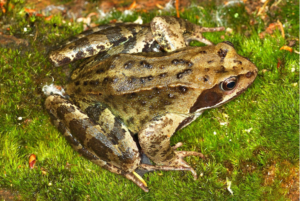Eco-evo dynamics of ranavirus infection in UK amphibian communities
In the late 1980s members of the public in the UK began reporting unusual mass mortalities of common frogs (Rana temporaria). These were caused by a virus from the FV3 group of ranaviruses, and FV3 ranaviruses are now recognised as a significant threat to amphibians in the UK, especially to common frogs which have suffered substantial population declines in the UK because of infection with these viruses. There have been multiple introductions of these viruses to the UK, and increasing temperatures in the UK appear to be exacerbating disease while human activities continue to redistribute the virus. There are many important questions which need to be answered if we are to predict the future of the epidemic and manage it to achieve the best outcomes for Britain’s amphibians.

A common frog, Rana temporaria. Photo (c) Fred Holmes/ARC
This studentship will use cutting-edge approaches to understand and predict the ranavirus epidemic in Britain, including a survey of both ranavirus and amphibian communities using environmental DNA (eDNA) techniques, coupled with a recently developed non-lethal test for infection of individual animals. Citizen scientists will be recruited to collect water samples for eDNA analysis and to provide reports of amphibian mortality, allowing us to build a detailed picture of the spatio-temporal structure of both the amphibian community and the extent and dynamics of the ranavirus epidemic. The unprecedented insight this will give will enable the student, for example, to compare the structure of the community and the pattern of the epidemic between urban and rural environments, and to understand how infection varies with the community of amphibians.
Despite the conservation importance of these viruses, there has been little successful epidemiological modelling of the host-virus system, and we are currently unable to predict the future shape of the epidemic with any confidence, nor the potential for evolution of tolerance or resistance in the amphibian population. For the second part of the project, therefore, the student will construct and analyse a detailed simulation model of amphibian communities and ranavirus infection in a spatially structured landscape, based on data from the survey plus further data from ongoing work on ranavirus occurrence in SE England. Modelling the epidemic into the future will allow the student to understand the likely effects of important aspects of the epidemic such as the changes in host age structure arising from the mortality caused by the ranavirus and differences in population mixing in urban and rural environments. A focus of the modelling will be asking questions about management options which might improve outcomes for amphibians; in particular, whether there are potential management interventions that would hasten the evolution of resistance and adaptation to the virus in common frogs.
The supervisory team for this project is ideal: Prof. Knell has experience in epidemiological modelling and in the use of eco-evo agent based models. Dr Lawson-Handley brings considerable expertise in aquatic eDNA sampling and analysis of ecological communities. Additional supervision from Prof. Garner (Institute of Zoology) will bring one of the leading authorities on ranavirus infection in UK amphibians into the project.
We are seeking a dedicated and enthusiastic student with a strong interest in conservation. Either coding or mathematical experience will be a benefit, if not then a strong interest in learning modelling techniques is essential. The student will gain important skills in eDNA analyses, in handling and analysing big datasets, in coordinating citizen science studies and in developing and interpreting simulation models.
